book6unit4reading(公开课)教学文稿
- 格式:ppt
- 大小:1.72 MB
- 文档页数:7

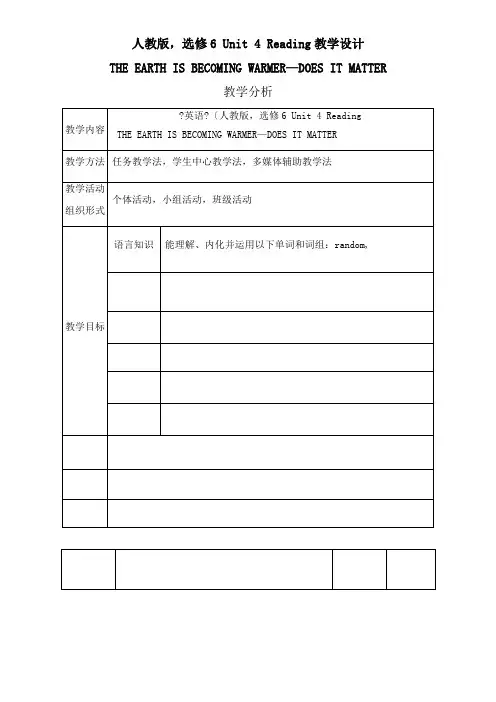
人教版,选修6 Unit 4 Reading教学设计THE EARTH IS BECOMING WARMER—DOES IT MATTER
教学分析
教学总结和反思
1、通过本堂课的学习,帮助学生了解了全球变暖的原因和对环境和人类的影响,研究与探讨了减缓全球变暖趋势的措施和建议,激发和培养了学生环境保护意识。
2、本节课课文难度不大,易于学生理解。
但要注意把握好活动时间,确保学生在合作学习〔讨论、交流〕的气氛中既学习语言知识又得到情感教育。
3、教学过程中应注意词汇拓展,借助对文章内容的兴趣,进一步培养语言学习的兴趣,引导学生综合运用语言的能力。
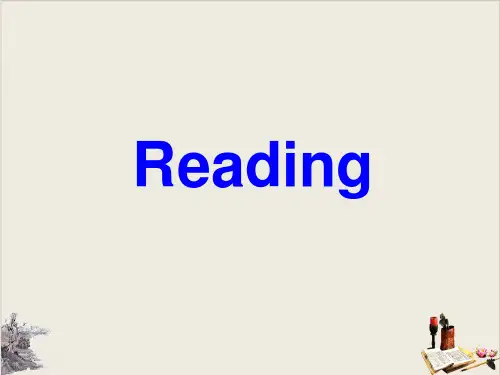
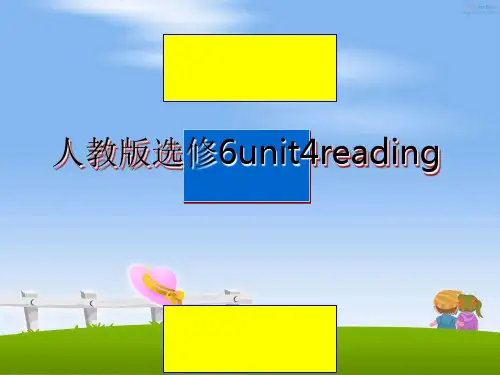
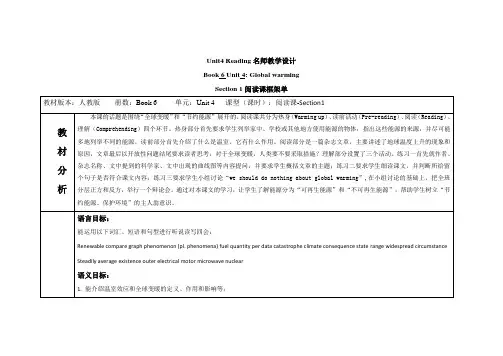
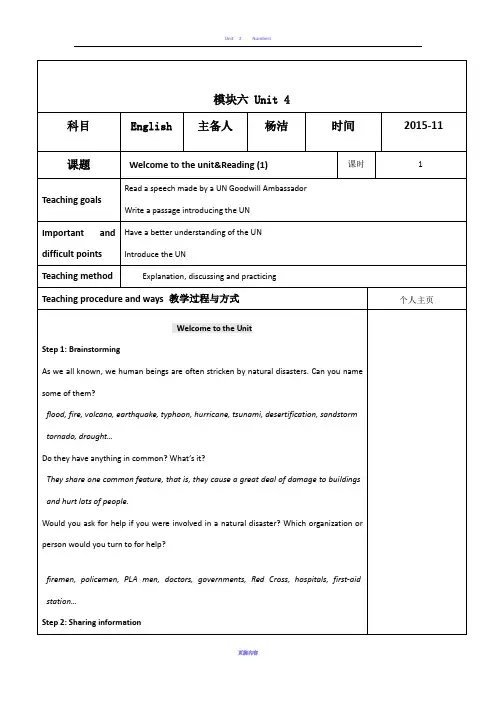
Look at the six pictures at page 49, these pictures present situations where people need international aid. Let’s have a discussion about them.Picture 1Can you guess from the caption what the main tasks of peacekeeping soldiers are?Do you think these soldiers play an important role in maintaining the world peace?Do you think this kind of job is very demanding, challenging and risky? Why or why not? When you grow up, would you like to do this kind of job if you had the chance? Why or why not?Picture 2What can you see in the picture?It is a picture of African children living in a poverty-stricken area. They suffer from malnutrition and hunger because of lack of food..Can you imagine what will happen to these hungry children if nobody helps?How do you feel when you see this picture?How can we help them?Picture 3What can you see in the picture?A flooded area.Suppose your home was struck by a flood, what would your life be like? Would you still live a normal life as before?No. For example, the roads would be blocked by the broken trees; the means of communication and traffic-roads and railway would be cut off.Picture 4What can you see in the picture?Water is being pumped into the fields.What factors can ensure a good harvest?What would happen if there was not enough water for farming?Farmers would be very worried about their crops if there was a drought, as a drought sometimes can cause a famine.Picture 5What is the doctor in the picture doing?Why do you think that doctors and nurses need to go to poor areas or countries to help? Picture 6Apart from the problems listed above, people in poverty are still facing many other difficulties. Can you name some of them?Do you think children can receive good education and good medical care in poor areas? Can their daily necessities be guaranteed? If not, what will happen?Step 3: DiscussionHave you ever helped people in need? What did you do to help them?Step 4: Homework1.Collect more information about international organizations helping people in need.2.Prepare the Reading part.Reading 1 The UN—bringing everyone closer togetherStep 1: Lead-inNow, we’re studying in the large, bright classroom equipped with advanced facilities. In this environment, most of us believe we can realize our dreams as long as we work hard. But look at these pictures. Do you think they have dreams as well? What do you think they can do to realize their dreams?So, we know that in other parts of the world, there are lots of children who are still struggling with starvation or war. Have you ever thought about doing something for those children to help them realize their dreams? If you have, what would you do?Step 2: Fast reading for general ideasGo through the passage as quickly as possible and try to find answers to the three。

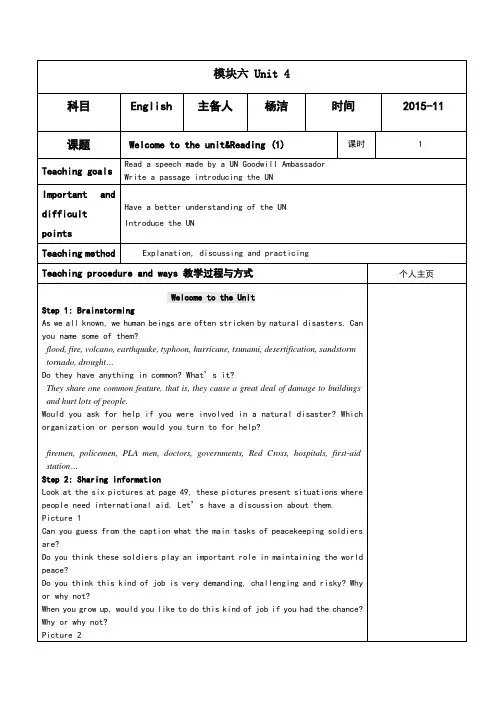
What can you see in the picture?It is a picture of African children living in a poverty-stricken area. They suffer from malnutrition and hunger because of lack of food..Can you imagine what will happen to these hungry children if nobody helps? How do you feel when you see this picture?How can we help them?Picture 3What can you see in the picture?A flooded area.Suppose your home was struck by a flood, what would your life be like? Would you still live a normal life as before?No. For example, the roads would be blocked by the broken trees; the means of communication and traffic-roads and railway would be cut off.Picture 4What can you see in the picture?Water is being pumped into the fields.What factors can ensure a good harvest?What would happen if there was not enough water for farming?Farmers would be very worried about their crops if there was a drought, as a drought sometimes can cause a famine.Picture 5What is the doctor in the picture doing?Why do you think that doctors and nurses need to go to poor areas or countries to help?Picture 6Apart from the problems listed above, people in poverty are still facing many other difficulties. Can you name some of them?Do you think children can receive good education and good medical care in poor areas?Can their daily necessities be guaranteed? If not, what will happen?Step 3: DiscussionHave you ever helped people in need? What did you do to help them?Step 4: Homework1.Collect more information about international organizations helping peoplein need.2.Prepare the Reading part.Reading 1 The UN—bringing everyone closer togetherStep 1: Lead-inNow, we’re studying in the large, bright classroom equipped with advanced facilities. In this environment, most of us believe we can realize our dreams as long as we work hard. But look at these pictures. Do you think they have dreams as well? What do you think they can do to realize their dreams?So, we know that in other parts of the world, there are lots of children【答案】①There was no further business,so the chairman closed the meeting./There being no further business,the chairman closed the meeting.②There happened to be no one in the room when the fire broke out.2. The UN—bringing everyone closer together.bring...together 使……和好, 团聚① The loss of their son _______ the two of them _______.丧子使他们重归于好。
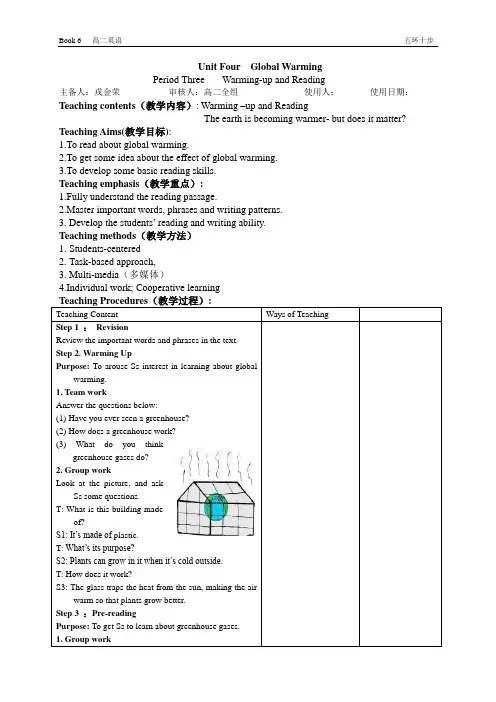
Unit Four Global WarmingPeriod Three Warming-up and Reading主备人:戎金荣审核人:高二全组使用人:使用日期:Teaching contents(教学内容): Warming –up and ReadingThe earth is becoming warmer- but does it matter? Teaching Aims(教学目标):1.To read about global warming.2.To get some idea about the effect of global warming.3.To develop some basic reading skills.Teaching emphasis(教学重点):1.Fully understand the reading passage.2.Master important words, phrases and writing patterns.3. Develop the students’ reading and writing ability.Teaching methods(教学方法)1.Students-centered2.Task-based approach,3. Multi-media(多媒体)4.Individual work; Cooperative learningUnit Four Global WarmingPeriod Four Reading主备人:戎金荣审核人:高二全组使用人:使用日期:Teaching contents(教学内容): ReadingThe earth is becoming warmer- but does it matter? Teaching Aims(教学目标):1.Grasp some words and phrases related to global warming.2.Train the students to master some reading strategies of scanning, skimming and finding out useful information.3.3.Encourage the students to take an active part in English study, develop their sense of co-operation.Teaching emphasis(教学重点):1.Help the students learn how to talk about global warming.2.Enable the students to talk about their opinions about the ways of dealing reducing global warming. Teaching methods(教学方法)1.Skimming and scanning; individual, pair or group work; discussion.2.A recorder, a computer, a projector .Unit Four Global WarmingPeriods 5 Learning about Language主备人:戎金荣审核人:高二全组使用人:使用日期:Teaching Goals:1. To enable Ss to master some new words and expressions.2. To get Ss to have knowledge of this grammar point: the subjective mood.Teaching methods(教学方法)1.Read the contents loudly.2.Task-based approach.3. Multi-media(多媒体)and the dictionaries.4.Individual work ; Cooperative learningUnit Four Global WarmingPeriod Eight&Nine Writing主备人:戎金荣审核人:高二全组使用人:使用日期:Teaching contents(教学内容): Enable the students to write an essay on one of the environmental problems.Teaching Aims(教学目标):1.Master several phrases and sentences used in the letters.2. Learn how to write good sentences in the letters by structure imitation.3. Learn how to protect environment.Teaching emphasis(教学重点):Master several phrases and sentences used in the letters by recitation. Teaching methods(教学方法)1.individual, pair or group work; discussion.2.A recorder, a computer, a projector .。

高二英语选修6 Unit 4 Reading 教学设计The earth is becoming warmer --- but does it matter?一、教学设计意图《高中英语新课程标准》中讲到“高中英语课程要有利于学生优化英语学习方式,使他们通过观察、体验、探究等积极主动的学习方法,充分发挥自己的学习潜能,形成有效的学习策略,提高自主学习的能力;要有利于学生学会运用多种媒体和信息源,拓宽学习渠道并形成具有个性的学习方法和风格。
”本课基于以上标准旨在借助于多媒体开展以词汇预热、图片和视频导入、读法指导、文章大意阅读、捕捉信息阅读、信息加工阅读、总结回顾性阅读等环节引导学生分层次的进行任务型阅读以实现引导学生高效阅读并且形成阅读报刊杂志类文章的基本方法和技巧。
二、教学目标设计:本节内容为一节分层次性任务型阅读训练课,整体的教学目标在于引导学生在以下两方面有所思考和收获:一、培养学生对科普性文章阅读的自信心。
二、帮助学生获得阅读报刊杂志类文章的基本方法和技巧,即通过分层次地阅读方法以有效地把握文章主旨、分析和处理细节信息、总结段落大意进而分析文章篇章结构等方面的能力。
三、在阅读的基础上,引导学生去进行分层次性任务型写作练习。
三、教材内容及重点、难点分析:教学重点:一、加强学生把握文章主旨大意的阅读能力。
二、培养学生分析处理细节信息的能力。
教学难点:一、寻找,归纳或者总结各段落主题句,关键词或者所探讨主要问题。
二、对文章篇章结构进行整体分析。
四、教学背景分析教学内容分析(含本课时在本课次的教学定位分析):一、本节阅读课中全球变暖的话题属于生僻的科普类,其主要特点就是专业术语和词汇较多和长杂句较集中,这无疑使学生的阅读兴趣降低和阅读的难度增加。
二,本篇课文内容节选自报刊杂志,有着明确的层次划分,主题句或者关键词,这些信息能够帮助学生快速准确把握文章的主题信息和细节信息。
三,在本课话题难度大但结构清晰的基础上,所以阅读的目的主要定位在引导学生由浅入深,由框架到主体地去理解,分析和加工文章信息。
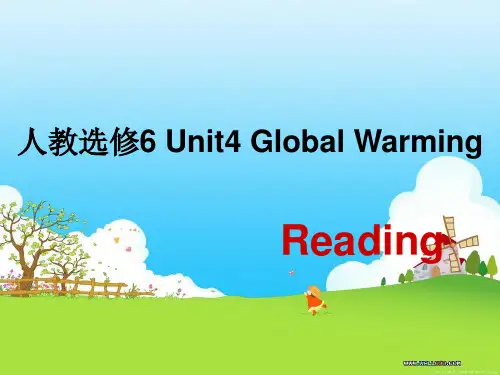
人教版新课标选修六Unit4Reading教案人教版新课标选修六第四单元教案参考Unit 4 Global warmingReadingTeaching goalsTarget languagewords and phrases:energy, light(v.), heat(v.), renewable, non-renewable, run out, compare, phenomenon,graph, fuel, trap, data, climate, catastrophe, consequence, range, per, glance, compareto, come about, fierce debate, result in, build up, keep onAbility goalsEnable the students to talk about different sources of energy.Enable the students to read the text, understand what it is about and talk about thecauses and effects of global warming.Teaching important difficult pointsEnable the students to get a better understanding of articles of this kind.Teaching aidsA projector and a blackboardTeaching proceduresStep 1 Warming upT:Now let’s look at a picture on the slide and answer the question below.What is the greenhouse made and used for?A greenhouse is made of glass and is used for growing plants, especially during coldweather.What’s greenhouse effect?Step 2 ScanningRead the text quickly and find the answer to the questions:1. Who wrote the magazine article? What is the name of the magazine?Sophie Armstrong, Earth Care.2. What are the names of the three scientists mentioned in the article?人教版新课标选修六第四单元教案参考Dr Janice Foster, Charles Keeling, George Hambley.3. What do they think about global warming? Do they agree with one another?They don't agree with each other.Dr. Janice Foster thinks the effects of global warming could be veryserious.George Hambley thinks global warming will be mild with few bad environmentalconsequences.Charles Keeling believes it is the burning of more and more fossil fuels that is resulting in a bigincrease in carbon dioxide.The first graph shows the temperature increase of one degree Fahrenheit between 1860to 2000.The second graph shows the carbon dioxide content in the atmosphere from 1957 to 1977.4. What are the two graphs about?The first graph shows the temperature increase of one degree Fahrenheit between 1860to 2022年. The second graph shows the carbon dioxide content in the atmosphere from 1957 to 1977.5. What is the main topic of the article?Global warming/ the warming of the earth.Step 3 SkimmingRead the passage carefully and judge whether the statements are true or false.1. The temperature last century didn’t increase much.2. Everyone believes that global warming is caused by the activities of humans.3. Janice Foster believes that global warming is caused b the burning fossil fuels.4. Natural gas is a greenhouse gas.5. Carbon dioxide is a byproduct of burning fossil fuels.6. People accept Charles Keeling’s data because he took accurate measurements.7. Flooding could be one of the effects of future global warming.8. George Hambley believes scientists are just guessing about the effects of globalwarming.9. George Hambley is worried about the effects of carbon dioxide onplant growth.10. It is clear what the effects of global warming will be.Keys: True: 3, 5, 6, 7, and 8 False: 1, 2, 4, 9, 10Step 4 Detailed readingRead the text carefully and try to find out how many parts we can divide the text into and find outthe main idea of each part.人教版新课标选修六第四单元教案参考Step 5 DebateGet into groups of six. Decide which three in your group are going to agree with thestatement and which three are going to disagree with the statement.Group A: We shall do something about global warming.Group B: We shall do nothing about global warming.Group A discuss why they agree with the statement; Group B discuss why theydisagree.Group A and B get together. Tell each other the reasons why agree or disagree withthe statement.Step 6 Homework1. Read the passage again and review the new words and expressions.2. Prepare the debate in groups.3. Surf the Internet for more information about global warming。
人教版高中英语选修6Unit 4 Global warmingReading: The earth is becoming warmer—But Does it Matter Teaching aims:1)Learn the causes of global warming and different attitudes.2) Master the reading skills.3) Save energy and prevent the global warming.|Important point:understand the causes and effects of global warming Difficult point:how to write a meaningful passage about global warming Teaching methods:individual, pair work, group discussionTeaching aidsa computer, some slides, a projector【Teaching procedures:Step 1 Lead- in1 Play a game—wheel of fortune设计意图:激发学习兴趣, 为阅读课文做好铺垫2 play a video and answer two questions设计意图:提前预知课文内容以便更好理解Step 2 Skimming1 Structure of the passage—1 Introduction2 Body3 Conclusion2 Match the main idea of each partPart 1 (A) How has global warming come aboutPart 2 (B) List two different attitudes^Part 3 (C) Should we do anythingPart 4 (D) The earth is becoming warmer设计意图:整体把握文章结构,思路清晰,便于理解文章内容Step 3 Scanning2 The Outline of different opinionsDr Janice Foster Charles Keeling George Hambley |Part 1This article is from ________.A. a magazineB. the internetC. a bookIntroductionof Greenhouse gasesand Greenhouse effect Made accurate measurements of the amount of CO2 ' Predict the global warming will be mild and positiveStep 4 Careful readingPart 21. What’s graph 1 about2. What’s graph 2 about¥3 How does the global warming come aboutPart 3Step 5 Post-reading —discuss1 We should do something or nothing about global warming.2 What can we do to reduce the global warmingStep 6 WritingWrite a short passage about global warming (100-120 words)Step 7 SummaryStep 8 Homework1 Finish your writing about global warming.2 Search for more information about global warming on theInternet.。